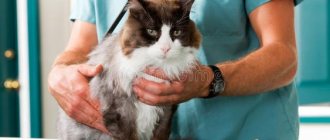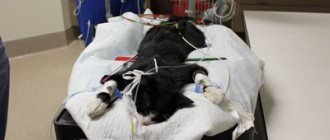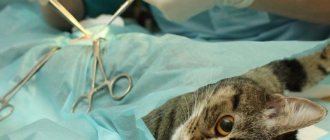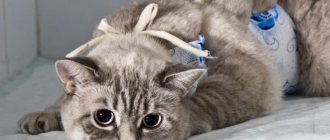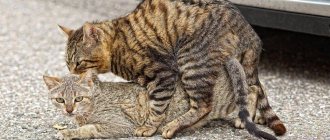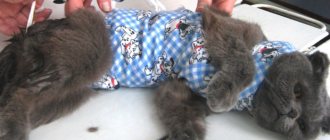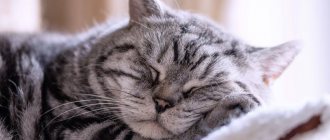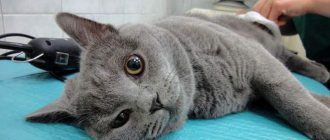The first hours after surgery
If the cat was castrated in a clinic, then the pet must spend the first hour there. This is the most difficult moment: the animal comes out of anesthesia, and the veterinarian must make sure that everything happens according to plan - no complications are observed.
The second and third hours spent at home are still quite difficult. The cat has general weakness and dizziness. He is most likely thirsty, but also feels nauseous. And what is most important to a pet now is the love and attention of its owner.
We recommend reading the article about the behavior of a cat after castration.
Key points to pay attention to at this time:
- Drying of the ocular conjunctiva. During the operation, the pet's eyes remain open. The doctor regularly moistens them using special drops. At home, this procedure should be done by the owner, placing tetracycline ointment or a special “Diamond Eyes” solution under the cat’s eyelids.
- Decrease in temperature. Most likely, at first it will remain at 37 °C, which is two degrees below normal. Your pet may experience mild tremors from time to time. Therefore, it is better to place it in a warm place and cover it with a blanket. As a last resort, you can use an electric heating pad in a case or a hot water bottle wrapped in a towel.
- Impaired coordination of movements. Due to high muscle weakness, when trying to stand up or walk, the cat may stagger from side to side. It is better to try to persuade him to lie down with gentle persuasion. This will pass in a couple of hours, now the main thing is to make sure that your pet does not fall, especially from a height.
- Refusal to eat. The cat is unlikely to develop an appetite in the first hours. Abstinence now is only good for him. Otherwise, vomiting may begin.
- Painful sensations. It is advisable to ask your doctor in advance what painkillers you can use. Signs that a pet is suffering may include dilated pupils, pursed paws, and aggression when attempting contact.
Nuances of postoperative care
After castration, the cat needs to be properly cared for. The owner’s task includes not only treating the wound and preparing the correct diet, but also other equally important responsibilities on which the recovery process of the pet cat will depend.
Can a cat lick a wound?
The cat should not be allowed to lick the operated area. This can lead to sutures coming apart, bleeding, and wound infection. That is why it is recommended to wear a special collar, which can only be removed during meals under the watchful supervision of the owner.
Why can't you jump after castration?
In the first hours after the operation, the owner should monitor every movement of the cat, which has not yet recovered from anesthesia. The effect of anesthesia disrupts coordination of movement and disorients in space. Jumping from a height should not be allowed; the cat may not calculate the distance and trajectory of the jump, which will lead to a fall and injury to the operated area.
After surgery, if possible, the animal should be prevented from jumping from heights and active play for the entire period of rehabilitation, until the wound is completely healed.
When can you wash your pet?
Experts do not recommend bathing a cat during the first month after castration. Bath procedures should be avoided for at least 10-14 days after surgery until the wound heals. In case of urgent need, you can clean the fur from dirt using special products or wet wipes.
What else can and cannot be done after surgery
Let's consider what other rules of care should be followed in the postoperative period and what is unacceptable to do after castration of a pet.
Recommendations for caring for a cat after castration:
1. Upon returning home after the procedure, the cat should be placed in a special carrier or placed on the floor where there are no drafts.
Do not place the carrier on high places or near heating appliances. 2. Place a tray and a bowl of water next to the cat’s bed. 3. In the first days after surgery, you need to monitor the cat’s body temperature and monitor the condition of the wound. 4. You should not let your pet outside in the first week after surgery. 5. If necessary, if the cat experiences pain after castration, you can give him painkillers as prescribed by the veterinarian. 6. If signs of postoperative complications are detected, the cat should be immediately shown to a veterinarian! By following these simple rules for caring for a domestic cat during the postoperative period, you can eliminate the risks of adverse effects of castration and significantly speed up the animal’s recovery process. Within 1-2 weeks, the cat will return to its normal life, and the owner will notice many positive changes in his behavior and character.
Treatment of the surgical wound
During the first two weeks, the surgical area must be inspected regularly and checked to avoid bleeding or infection of the wound.
During the first week, to speed up the healing of the stitches, they should be treated with hydrogen peroxide twice a day and smeared with a solution of brilliant green. Later you can use iodine. In case of the slightest redness, you can lubricate the surgical area with Levomekol.
To prevent the cat from injuring the operating area, it is better to put a special collar on him for the first days. Otherwise, as a result of licking, the seams may come apart.
It is better to do the operation in winter or autumn. During this period, the likelihood of wound infection is less. During the summer, your veterinarian will usually prescribe a course of antibiotics for at least five days.
Prevention of complications
Pet owners are most often interested in how the cat’s wound healed and how long it lasted. Recovery time largely depends on the owners themselves.
If the animal has a predisposition to kidney and heart diseases, it is recommended to give it a maintenance dose of medication without waiting for symptoms of the disease. Before choosing a drug, you should consult with the surgeon who performed the operation, as well as with your animal’s attending physician.
To reduce stress, the cat should be placed in a separate room and its contact with children and other animals should be limited. A bowl of food and water should be placed nearby. To relieve anxiety, you can give your pet the drug Kot-Bayun.
All information posted on the site is provided in accordance with the User Agreement and is not a direct instruction to action. We strongly recommend that before using any product, you must obtain a face-to-face consultation at an accredited veterinary clinic.
Toilet
As soon as the cat begins to stand up, it is necessary to place a litter tray with low sides near the bed. It is better to add a filler (silica gel is better, it does not create dust and dirt) that is light in color, so that you can immediately see if there is bleeding or pus.
If this is necessary, then on the first day you can use special diapers for cats.
If the cat avoids the toilet in the first days, this is understandable. Firstly, he had hardly eaten or drunk anything yet. Secondly, he experiences pain and discomfort and delays this moment. As a last resort, you can give your pet a little Vaseline oil.
It’s also okay if the cat goes to the toilet in small portions. This is normal for the first days. Within a month everything should be back to normal. And, most importantly, the urine will no longer have a pungent odor.
How is castration performed?
The cat can be operated on at home or in a veterinary clinic - at the owner’s request. There is no difference, besides, in a home environment the cat will experience less stress than in an unfamiliar place. First, the cat doctor will examine the pet to make sure that the mustachioed patient is completely healthy and the risk of complications will be minimal.
If the veterinarian doubts anything, he will prescribe additional tests and examinations for the cat. Drugs in different veterinary clinics may differ in price and purpose. Depending on the cat’s condition, the doctor can offer the owner several options for preparatory injections and anesthesia itself. The most important thing is to administer anesthesia to your pet and successfully “turn off” his consciousness. The cat will not feel pain or discomfort.
The whole operation lasts no more than 5 minutes, and the cat lies with its eyes wide open. The doctor periodically closes his eyelids to moisten the conjunctiva. Dry eyes should not be allowed. First, the cat's surgical site is decontaminated, then a small longitudinal incision is made on the scrotum and the testis is removed in several stages. After the operation, a special treatment is performed: blood clots are removed and sprinkled with an antiseptic.
Cat nutrition after castration
In the first hours and days, due to the effects of anesthesia and pain, the cat will not have time to eat. The main thing is not to force your pet to eat, this will only irritate him once again. Clean and fresh water should always be nearby. As soon as the nausea passes, the cat will quench its thirst.
Soon your appetite will return and, most likely, it will be increased. Overeating should not be indulged. Changes in hormonal levels can easily lead to obesity and related diseases. But if the cat refuses to eat two days after the procedure, this is an alarming factor. You need to contact a veterinarian.
As for the diet, it is better to gradually switch to special food for neutered cats or preventive food to prevent urolithiasis. If your pet is on a natural diet, remove fish and any food excessively enriched with calcium, phosphorus, and magnesium from the daily diet.
Dry food causes acidification of urine, which is also a prevention of urolithiasis, so this diet should be preferred. But drinking should always be plentiful. Read more in the article on what to feed a neutered cat.
How quickly does a cat come to his senses?
The average recovery time from anesthesia is 2-8 hours. 24 hours after general anesthesia, the animal fully recovers, but it must be cared for no less carefully. When talking about how cats behave after castration, veterinarians emphasize several points:
- animals become timid and wary of the slightest noise;
- familiar objects and people can become sources of fear for pets;
- gag reflexes and involuntary urination are possible;
- Thirst increases after anesthesia, so after recovering from anesthesia, you can give the cat something to drink through a pipette, and a little later place a bowl of clean water next to the bedding.
If the recommendations are followed, the animal’s well-being improves within 24 hours after recovery from anesthesia.
Mr. Cat recommends: possible complications
Typically, recovery after castration proceeds calmly, without deterioration of the condition. But you need to be aware of what cases may occur and be prepared for them.
Complications can be early or late.
Their first signs may appear on the operating table. They are expressed in bleeding and prolapse of the omentum or testes - the organs closest to the operating area. Good recovery care will help resolve this problem quickly.
Late complications are most often associated with wound infection. There may be several reasons - unsterile instruments, poorly treated surgical area, violations in postoperative care.
Symptoms that should cause concern to the owner:
- Increase in body temperature by more than two degrees above normal.
- Change in gait. They often say that the cat is experiencing pain and discomfort.
- Refusal to eat, apathy for several days.
- Increased thirst or refusal of water.
- Nasal discharge, sneezing.
- Pain when palpating the operating area.
- The cat has difficulty going to the toilet.
- Discharge from the wound in the form of pus and ichor.
- The pet's heavy breathing, shortness of breath, arrhythmia and tachycardia.
It is necessary to immediately contact the surgeon who operated on the cat and tell him about the alarming symptoms.
The most common complication, but nevertheless rare, is inflammation of the scrotum and surrounding tissues. If your pet has cryptorchidism, then this pathology is much more difficult for them to tolerate. Since the castration procedure itself was more difficult, because with this phenomenon the testes do not descend into the scrotum, and the operation becomes essentially cavitary. Usually the recovery period in this case is longer.
How is the castration procedure performed?
- Six are removed from the surgical site.
- The skin of the scrotum is lubricated with iodine.
- The skin above the testes is cut.
- The vaginal ligaments are cut with scissors or a scalpel.
- The vaginal lining is removed.
- The testis is removed or a special thread is tied around the spermatic cord to form a knot and the vas deferens is amputated.
- The wound edges are treated with iodine.
- Identical actions are performed on the second organ.
- The edges of the operated tissues are not sutured because the recovery is fast.
Should a cat be spayed: indications for surgery
The behavior of an unsterilized domestic cat during the period of heat can be quite aggressive, accompanied by restless meowing, loud screaming, and the pet’s desire to escape from the house. The consequences of this may be mating with street animals, unwanted offspring for owners, infectious diseases, injuries, etc.
Sterilization will help to avoid these troubles - during this operation, the cat's fallopian tubes are tied. The main risk during sterilization is anesthesia, so the operation should be performed in a good veterinary clinic with experienced specialists.
Indications for cat sterilization:
- preventing unwanted pregnancy and unwanted behavior associated with estrus;
- prevention of the development of pathologies (tumors of the mammary glands and uterus);
- purulent inflammation of the uterus;
- tumor of the ovaries or uterus.
